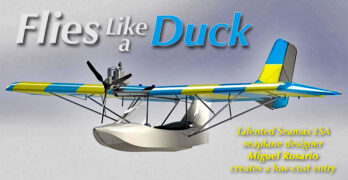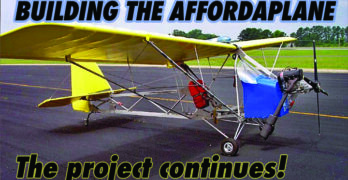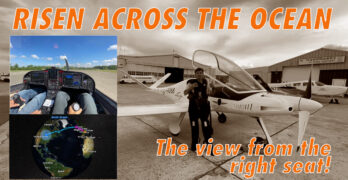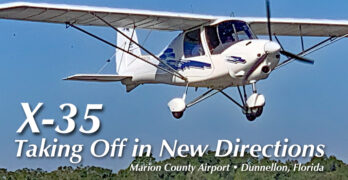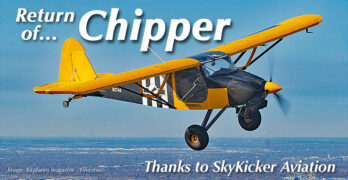Article Updated July 17, 2024 — After this article was posted, Miguel Rosario reported, “Duck is still in tests. Now we will install a 912 ULS 80-horsepower engine, as requested by future customers.” He continued, “Molds are under construction for production, which we hope to start in three months” (approximately October 1, 2024). He finished, “I will keep you updated on all developments regarding Duck.” —DJ
You probably know Seamax. This longtime, performance-oriented LSA seaplane was one of the first to make a splash in the U.S. light aircraft market way back in December, 2007.
Today, regretfully, the Seamax company is going through some very difficult circumstances as noted in this State of the Seaplane Sector report. We don’t know the end of those stories yet.
Nonetheless, Seamax M-22 designer Miguel Rosario remains active. You can’t keep a good man down but apparently you can keep him on the water.
Search Results for : Flight Design
Not finding exactly what you expected? Try our advanced search option.
Select a manufacturer to go straight to all our content about that manufacturer.
Select an aircraft model to go straight to all our content about that model.
Building the Affordaplane, Part 3
In the previous installment, I described construction details for the fuselage section of the Affordaplane ultralight project. Now let’s look at construction of the empennage and wing assemblies. Remember, this is a plans-only type of build using off-the-shelf materials and tools intended for a novice builder. Keep this objective in mind when reviewing the construction and design details. A complete free video series on YouTube shows each step of this construction.
The components of the empennage (rudder, elevator, vertical and horizontal stabilizers) are all formed from 1-inch 6061-T6 aluminum tubing. These tubes must be bent into their respective shapes, matching template patterns drawn on your workbench. (Use some craft paper for this!) What is the easiest way to form these simple bends? I found that using an electrician’s conduit bender did the job nicely. With a little practice, each tube was formed to the proper shape and then fitted with a gusset to join its ends.
Inside the Transatlantic Crossing of the Risen
We recently reported that the newest version of the sleek, retractable-gear Risen had made a successful transatlantic crossing. From what we could piece together from outside accounts and posts on social media, it went well. But here’s a more first-person look at the crossing, from the perspective of the right seat.
Andrea Venturini accompanied designer Alberto Porto on the epic journey across the pond. Here’s his account.
It all started last December, with a phone call I received from Alberto Porto. At the time, I was in Australia doing a report at the Gliding World Championship for theItalianTeam. Onthephone Alberto, designer and builder of the fastest ultralight in the world (430 kph/232 knots), with the simplicity that always distinguishes him, says: ”Andrea, keep yourself free for next June, I’ll detail everything when you return to Italy.”
You can imagine my curiosity in the meantime. A few weeks later, the mystery was revealed: the Risen Superveloce with the brand new Rotax 916 iS must be brought to Oshkosh, to AirVenture, the largest and the most important aviation fair ‘of the Universe.’ I knew well what Oshkosh meant.
Advanced Degree in Rotax-erie
Editor’s Note: This story originally appeared in KITPLANES magazine but since so much of the LSA world depends on Rotax engines, we thought this was worth a read here.
Thirteen years into my two-year SeaRey build, OspRey finally had its engine mounted. But when I signed on the dotted line for my new Rotax 914, and with little more knowledge than how to change the oil in my car, I was nervous about my abilities to maintain this expensive engine. Because of this, back in 2014, I attended a weeklong service and maintenance class at Canadian Rotax distributor Rotech Motor, Ltd. Thanks to an excellent hands-on instructor, who acted like he had all the time in the world and a bagful of instructor tricks to teach us, by the second afternoon I had dropped my skepticism and distrust of the price/power ratio of the Rotax engine and was (almost) ready to go out and get a Rotax tattoo.
MOSAIC – A Different Perspective
A lot has been written about the contents of the MOSAIC NPRM and many people and organizations have been able to comment on it to the FAA. Much of the commentary has been around the extension, or in some cases, curtailing of existing privileges for Sport Pilots, aircraft that can fit into the Light Sport definition and Light Sport Repairman certifications. I don’t plan to re-hash any of that here. This article will focus on what some of these changes could mean, in practical terms, to the market for Light Sport Aircraft and its customers. As you will see, it has the potential to be highly disruptive which not everyone will be happy about but will do so in a way that also opens up opportunities to a wider audience.
Before delving any deeper, let’s dispel the myth held by some in general aviation that Light Sport has been a “failure”.
Grassroots Success Story — Dunnellon’s X35 Attracts New, Younger Aviation Businesses
If I’ve heard one lament repeatedly over a long career, it is that current pilots don’t see enough new pilots coming into aviation. Are you one who worries a little or a lot about that? If not, you are a rare pilot.
Is it any wonder, though? The price of aircraft is way, way up. This applies to used aircraft and new — just like it does with your groceries or gasoline. The cost of maintenance is high and rising. Insurance is very expensive (for airplanes as well as cars or houses). Hangars are unavailable with years-long waiting lists at many airports.
More than ever it can seem, aviation is an activity for those with fairly thick wallets. The squeeze on modest budgets has rarely been this demanding.
Yeah, all that, but this website nonetheless discovers the affordable end of aviation. In that pursuit, I was drawn to an airport with an encouraging twist on the affordability squeeze play.
Building the Affordaplane, Part 2
In a previous post, introduced our video project for building the Affordaplane. To review, this is the plans-only project I demonstrated on YouTube for building an ultralight from raw materials. (You’ll find this free 50-part series here.)
My objective was to build an “FAA-legal” ultralight using approved aircraft materials and techniques. This month, I will review some of the challenges encountered while building. My approach on making these videos was to show and explain to first-time builders how to take a set of plans and translate them into a series of steps for completing the project.
From a construction standpoint this ultralight design is quite unusual in some ways and very traditional in others. The designer, Dave Edwards, had a goal of making sure the aircraft could be built by an amateur with common shop tools and readily available materials.
New Buyer for Icon Reported — What Happens Now?
Icon is a global enterprise. While its headquarters remains in Vacaville, California, fabrication is done in Mexico, and ownership is in China. For some years, this American start-up has benefitted from Chinese investment.
How much investment has this California company attracted? Numbers I’ve been quoted vary enormously but all estimates run into many millions of dollars. If these guesses are even close to accurate, Icon has generated more investment funding than nearly any LSA producer. Only one outstrips them. That was a reported $200 million sale of Pipistrel to Textron, owner of Cessna and other aviation brands. I hope the aerospace conglomerate got all they hoped for because that is a super-premium valuation for any LSA company, even one as tech-savvy as Pipistrel.
Icon has performed reasonably well in recent years (“200 Delivered” report) but prior investments in the company require sales volumes that are difficult to reach, especially with a $400,000 price tag.
So, You Want to Build An Ultralight?
Ever consider what it might be like building an ultralight? But first, how do ultralights fit into the arena of “regular” Experimental airplanes like the ones featured in KITPLANES Magazine and other Light Sport Aircraft found on this website? For those not familiar with the technicalities of an ultralight, allow me to briefly summarize the details of what defines an ultralight. Then we’ll consider how they complement their larger brothers.
While you may hear pilots and builders use the term ultralight to describe a small, light aircraft in general terms, the FAA has very specific rules as to what constitutes an ultralight. Full details are spelled out in Part 103 of the FARs, but here are the highlights.
An ultralight has a single seat (pilot-only capable), an empty weight of no more than 254 pounds and a maximum speed of 63 mph. So, if you ever see a small plane with more than one seat, or one that obviously weighs more than 254 pounds, that aircraft does not meet the legal criteria of an ultralight.
Like Phoenix Rising, Belite Chipper Returns to Production by SkyKicker Aviation
Welcome back to the airplane equivalent of an old friend. As you can see at the bottom of this post, Videoman Dave and I did many video interviews with Chipper creator. James Weibe (view at bottom). Pilots seemed always to enjoy hearing about his latest development.
James came to aviation from the computer business, where the pace isn’t fast — it’s furious! Over the years Dave and I covered James and his output, we’d make a new video at every airshow, it seemed, as he had moved on from the last design to the next. That’s what they do in the world of computers but it made pilots’ heads spin.
It also probably slowed sales because, as with computers, why buy this airplane when the next one will be even better?
It Began with Kitfox Lite
James started out with the Kitfox Lite single place Part 103 ultralight vehicle. Current Kitfox owners did not plan to pursue the single seater that Kitfox founder Dan Denney had created years earlier.
- « Previous Page
- 1
- …
- 44
- 45
- 46
- 47
- 48
- …
- 147
- Next Page »


